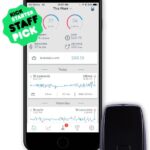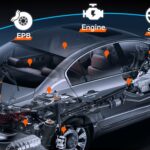Are you struggling to connect your OBD2 scanner to your iPad? You’re not alone. Many users encounter difficulties when trying to link these devices, especially when using Bluetooth. This article delves into why your OBD2 scanner might not be connecting to your iPad and explores potential solutions to get you back on track with your car diagnostics.
The ELM327 Bluetooth OBD-II adapter is a popular tool for car enthusiasts and mechanics alike. It plugs into your vehicle’s OBD2 port, allowing you to access a wealth of data from your car’s computer, including engine performance and diagnostic codes. Ideally, you should be able to pair this Bluetooth device with your iPad (or iPhone) and use a compatible app to read this data.
However, unlike Android devices which generally pair seamlessly with ELM327 via Bluetooth settings, iPads and iPhones often fail to establish a direct Bluetooth connection. Users find that the ELM327 device simply doesn’t appear in the Bluetooth device list on their iOS devices. This is a frustrating issue, leading many to question why iOS devices seem incompatible with these handy OBD2 scanners via Bluetooth.
The core reason behind this connectivity problem lies in how iOS handles Bluetooth connections, particularly with OBD2 devices. Apple’s iOS operating system is known for its robust security measures and specific Bluetooth protocol implementations. Standard ELM327 Bluetooth adapters often utilize Bluetooth profiles that are not fully supported or are restricted by iOS for security and compatibility reasons. While Android is more flexible in allowing connections with a broader range of Bluetooth profiles, iOS is more selective, often prioritizing specific types of connections like audio streaming or data transfer within the Apple ecosystem.
This limitation means that while your Android phone might readily recognize and pair with the ELM327 adapter as a generic Bluetooth device, your iPad, with its stricter Bluetooth protocols, may not. It’s not necessarily a fault of the OBD2 adapter itself, but rather a constraint imposed by the iOS Bluetooth framework.
So, what are your options if you’re determined to use your iPad for car diagnostics? Fortunately, there are workarounds:
-
Wi-Fi OBD2 Scanners: Instead of Bluetooth, consider using a Wi-Fi enabled OBD2 scanner. These scanners create their own Wi-Fi hotspot that your iPad can connect to directly. Because the connection is over Wi-Fi rather than standard Bluetooth pairing, it bypasses the Bluetooth compatibility issues inherent in iOS. Many OBD2 apps are designed to work with both Bluetooth and Wi-Fi scanners, giving you flexibility.
-
Dedicated Apps and Specific Bluetooth Adapters: Some OBD2 scanner manufacturers offer specific Bluetooth adapters that are designed to be compatible with iOS devices. These adapters often use Bluetooth protocols that are whitelisted or specifically supported by iOS. Furthermore, certain OBD2 apps in the App Store are engineered to work with these specific adapters, often handling the connection process within the app itself rather than relying on the standard iOS Bluetooth settings menu. Researching apps and adapters that explicitly advertise iOS compatibility is crucial.
In conclusion, the frustration of “why won’t my OBD2 connect to iPad?” stems primarily from iOS’s Bluetooth protocol restrictions rather than a fundamental incompatibility with OBD2 technology. While direct Bluetooth pairing with standard ELM327 adapters is often problematic, exploring Wi-Fi OBD2 scanners or researching iOS-compatible Bluetooth adapters and dedicated apps offers viable pathways to achieve car diagnostics on your iPad. As technology evolves, and with increasing demand for seamless device integration, we may see improvements in Bluetooth compatibility between OBD2 scanners and iOS devices in the future.
References:
- On-Board Diagnostics: http://en.wikipedia.org/wiki/On-board_diagnostics
- Soliport Bluetooth OBDII Scanner: http://www.amazon.com/Soliport-Bluetooth-OBDII-Diagnostic-Scanner/dp/B004KL0I9I/ ref=pd_sxp_grid_pt_0_2

